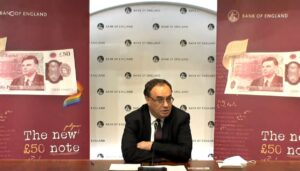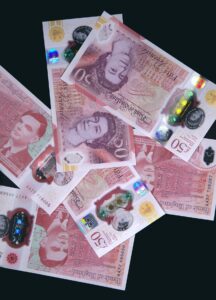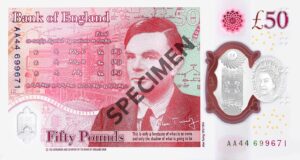
The Bank of England have unveiled, on 25th March 2021, the design and security features for the new £50 banknotes featuring noted scientist and computer pioneer Alan Turing (1912 – 1954). The Bank confirmed that Turing would be featured on the new polymer banknotes in July 2019 during a presentation event at the Science and Industry Museum in Manchester which was presided over by then-Governor Mark Carney. The process to unveil the design and personality to be featured on the UK’s next £50 banknote all began when the Bank of England asked the country in November 2018 who should be portrayed on the reverse side. After a voting process that lasted nearly six weeks, and, for the most part, was carried out online, the bank received a total of 227,299 nominations. The process of streamlining this list down to a more manageable number of personalities fell to the Bank of England’s Banknote Character Advisory Committee (BCAC). The seven-member committee initially ended up with a still sizable list of 989 eligible names that met the criteria of people who were not fictional, now deceased, and who had contributed to their field of expertise in the United Kingdom. In the case of the £50 denomination, the subject of science was the chosen field of expertise. Ultimately the list was fine-tuned to 12 final choices and, with the assistance of the Advisory Committee, former Governor Mark Carney had the final say.

Turing Banknote Unveiled Online
The finished banknote in terms of its design and security features was unveiled by Bank of England Governor Andrew Bailey at the Bank’s headquarters on Threadneedle Street, London. Due to the current COVID-19 restrictions in place, the unveiling took place online with a prepared video shown on their youtube channel where Governor Bailey was joined by entertainer Stephen Fry and Dr. Simon Singh, British popular science author, theoretical and particle physicist. Afterwards, the Governor fielded questions from the media with a live online newsfeed.
In his opening comments, Governor Bailey emphasised the immeasurable contributions made by Alan Turing during the Second World War.
“At the root, it’s because Alan Turing represents something of which we’re all very proud, even if we can’t precisely articulate the reason. I believe that part of the answer lies in him being someone who, not content with abstract ideas, applied himself to the physical embodiment of those ideas. And from his sheer force of will, came enormous leaps of progress”. (Andrew Bailey, Governor, Bank of England – 25th March 2021)
Governor Bailey also touched on Turing’s personal life by acknowledging the arrest and conviction he endured under the-then indecency laws in 1952. The tragic events surrounding this arrest would eventually lead to Turing taking his own life, at the age of just 41. Queen Elizabeth II granted Turing a posthumous pardon in 2013 and in 2017 the Turing Law was passed in memory of Alan, pardoning all men who, like him were convicted on such laws based on their orientation.
Turing: Father of Theoretical Computer Science and Artificial Intelligence
Now regarded as the father of theoretical computer science and artificial intelligence as we understand it today, it is perhaps one of Turing’s most sensational accomplishments, the recreation of the machine and process which deciphered the German “Enigma” code. Historians believe Turing’s extraordinary efforts shortened the war by perhaps as much as two years and saved the lives of 14 million civilians and military personnel. In 1946, he was appointed an officer of the Order of the British Empire by King George VI for his wartime services. Much of his work remained secret for many years due to the Official Secrets Act, and, as such, he received little recognition for his work during his lifetime. Although famous for his work on codebreaking and computing, Alan Turing is less well known for his discoveries in the field of biology. He was a pioneer of morphogenesis, where he used mathematics to understand how natural patterns like the spiral formation of the seeds in a sunflower head, and the arrangement of spots on a leopard can form.
The New £50 Note Is Slightly Smaller
The new £50 note measures 146 / 77 mm., which are slightly smaller than the paper £50 notes issued 2011 and features the signature of Sarah John, the Bank’s Chief Cashier since 2019. The notes retain their red colour and contain advanced, updated security features, completing the Bank of England’s most secure set of polymer banknotes yet. During the Bank’s presentation, they highlighted the benefits of polymer banknotes as have a longer life-span than paper notes as they remain in better condition during their use. This note, like the polymer £10 and £20 also contain a tactile feature to help visually impaired people to easily identify the denomination.

Turing Banknote: Facts and Features
Featured on the reverse or back is a photo of Alan Turing taken in 1951 by Elliott & Fry which is part of the Photographs Collection at the National Portrait Gallery. Alan Turing provided the theoretical underpinnings for the modern computer. While best known for his work devising code-breaking machines during WWII, Turing played a pivotal role in the development of early computers first at the National Physical Laboratory and later at the University of Manchester. He set the foundations for work on artificial intelligence by considering the question of whether machines could think. His legacy continues to have an impact on both science and society today.

The front or obverse side retains the portrait of HM Queen Elizabeth II originally introduced onto Bank of England banknotes in 1990.
Key security features include:
- See-through windows: Located toward the left half, there is a gold and green foil application containing the image of a computer micro-chip and a stylised sunburst. A second, smaller window in the bottom corner and to the right of the Queen’s portrait includes slightly raised tactile numerals of 50.
- Hologram: When the note is tilted, a hologram application below the window changes appearance, alternating the words Fifty and Pounds. The image of HM Queen Elizabeth II is also visible to the left of the image of the computer chip. Above the see-through window is a 3D foil image of St Edward’s crown.
- Red foil patch: Located on the reverse side of the note and above the see-through window, a metallic, red foil patch in the shape of a stylised sunflower contains the letters AT.
- UV Print: When the front side of the note is viewed under an Ultraviolet light, the number 50 appears in bright red and green and placed over the raised print BANK OF ENGLAND shown against a dull background.
- Tactile feature: On the front or obverse side of the note, there are four clusters of raised dots in the top left hand corner. This tactile feature helps blind and partially sighted people identify the value of the note.
- Unique numbering: A unique serial number is printed horizontally and vertically on the back of the note. The horizontal number is in the bottom right corner and is comprised of multi-coloured letters and numbers, which increase in height from left to right. The vertical number runs down the left-hand side and the numbers and letters are the same height and colour.

Key elements of the notes’ design on the reverse:
- Mathematical table and formulae: Taken from Turing’s seminal 1936 paper “On Computable Numbers, with an application to the Entscheidungsproblem” Proceedings of the London Mathematical Society. This paper is widely recognised as being foundational for computer science.
- Automatic Computing Engine (ACE): This pilot Machine which was developed at the National Physical Laboratory as the trial model of Turing’s pioneering ACE design. The ACE was one of the world’s first electronic stored-program digital computers.
- Binary Code: A ticker tape image depicting Alan Turing’s birth date of 23 June 1912 is shown in binary code, computer processing data using a two-symbol system of 0 and 1.
- The British Bombe: Technical drawings outlining Turing’s machine which became one of the primary tools used to break Enigma-enciphered messages during WWII.
- The ACE Progress Report: A series of key background images, depicting technical drawings from Turing’s Automatic Computing Engine project.
- Times Newspaper Quote: “This is only a foretaste of what is to come and only the shadow of what is going to be” The prophetic quote from Alan Turing given in an interview to The Times newspaper on the 11th June 1949.
- Facsimile signature: Turing’s signature from 1947 is replicated from the visitor’s signature book which is on display at Bletchley Park Trust where he worked during WWII.
The Turing £50 note will shortly join the other three denominations comprising the G series of banknotes which includes the Churchill £5, the Austen £10 and the Turner £20, meaning all Bank of England banknotes are now printed on a polymer substrate. The public will begin to see the new £50 enter general circulation from the 23rd June 2021 – the 109th anniversary of Turing’s birth. The public can continue to use paper £50 notes as usual as notice will be given at least six months ahead of the date when the £50 banknotes featuring images of 19th century industrialists Matthew Boulton & James Watt is withdrawn.
The author, Michael Alexander, is president of the London Banknote and Monetary Research Centre.
For additional information on this and other banknotes issued from the Bank of England, please visit the Bank of England website.
Last autumn, Michael explained why there were so many banknotes missing and an amount of unused British coins.
The Bank of England Museum has been smartified and you can visit some exhibitions online.




